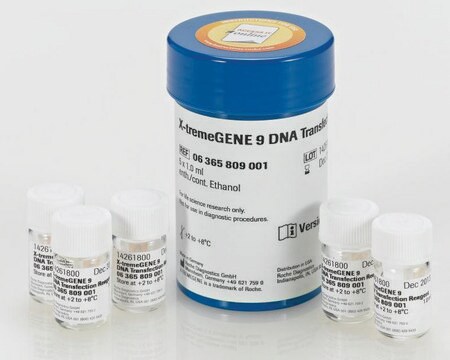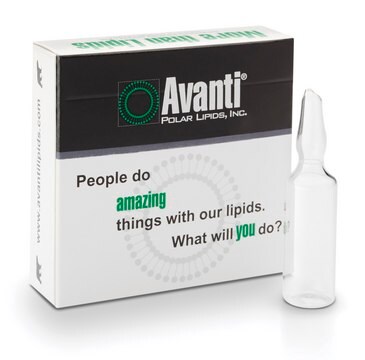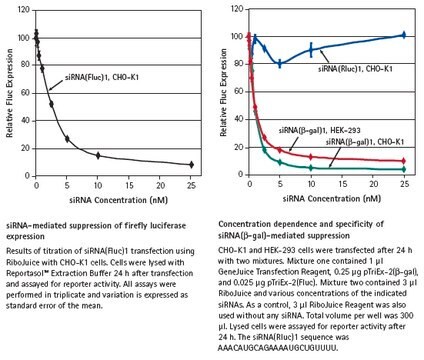Key Documents
L3287
Escort™ IV Transfection Reagent
Lipid reagent for transient and stable transfection of mammalian and insect cells.
Synonim(y):
Gene delivery
About This Item
Polecane produkty
klasa czystości
for molecular biology
Poziom jakości
Postać
liquid (aqueous solution)
zastosowanie
1 mL sufficient for 160-500 transfections
stężenie
1 mg/mL
metody
transfection: suitable
temp. przechowywania
2-8°C
Powiązane kategorie
Opis ogólny
Zastosowanie
Cechy i korzyści
- Suitable for stable and transient transfection
- Optimized for a wide variety of cell lines
- Low toxicity
- Compatible with both serum and serum-free transfection protocols
- Ideal for Sf9, Sf21 and S2 insect cells
Komponenty
1 mg/mL total lipid in water
Note the identity of the lipids used in Escort™ IV is confidential.
Przestroga
Zasada
Informacje prawne
produkt powiązany
Kod klasy składowania
10 - Combustible liquids
Klasa zagrożenia wodnego (WGK)
WGK 3
Temperatura zapłonu (°F)
Not applicable
Temperatura zapłonu (°C)
Not applicable
Środki ochrony indywidualnej
Eyeshields, Gloves
Certyfikaty analizy (CoA)
Poszukaj Certyfikaty analizy (CoA), wpisując numer partii/serii produktów. Numery serii i partii można znaleźć na etykiecie produktu po słowach „seria” lub „partia”.
Masz już ten produkt?
Dokumenty związane z niedawno zakupionymi produktami zostały zamieszczone w Bibliotece dokumentów.
Klienci oglądali również te produkty
Produkty
Transfection is the introduction of DNA, RNA, or proteins into eukaryotic cells and is used in research to study and modulate gene expression. Thus, transfection techniques and protocols serve as an analytical tool that facilitates the characterization of genetic functions, protein synthesis, cell growth and development.
Transfekcja wprowadza materiał genetyczny do komórek, wspomagając badania nad ekspresją genów i biologią komórek.
This brief webinar provides an overview of what transfection is and the methods that are used to introduce DNA or RNA into eukaryotic cells.
Protokoły
Lipid Transfection Optimization Protocol
Sigma's Universal Transfection Reagent is a unique formulation of a proprietary polymer blend used for transient and stable transfection of nucleic acids into various eukaryotic cell lines and hard-to-transfect primary cells. Fast and easy protocol is compatible with serum, serum-free medium and antibiotics
Escort™ IV Transfection Reagent Protocol
Biuletyn produktu zawiera szczegółowy protokół użytkowania ułatwiający transfekcję DNA.
Nasz zespół naukowców ma doświadczenie we wszystkich obszarach badań, w tym w naukach przyrodniczych, materiałoznawstwie, syntezie chemicznej, chromatografii, analityce i wielu innych dziedzinach.
Skontaktuj się z zespołem ds. pomocy technicznej











